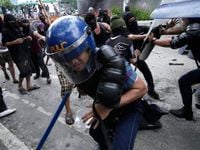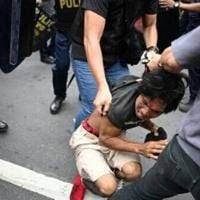On Sunday, September 21, 2025, Manila’s streets became the stage for one of the largest anti-corruption demonstrations in recent Philippine history—a day that began with peaceful protest but soon spiraled into violence, mass arrests, and a citywide reckoning with the scale of government scandal. According to reports from Al Jazeera and AFP, more than 200 individuals were detained by police after confrontations erupted between authorities and masked demonstrators, some of whom were minors as young as twelve.
The events unfolded against the backdrop of a ballooning scandal involving fraudulent flood-control projects—so-called "ghost" infrastructure schemes—that have reportedly cost Filipino taxpayers billions of pesos. The Department of Finance estimates the economic loss from these projects reached as much as 118.5 billion pesos (about $2 billion) between 2023 and 2025. President Ferdinand Marcos Jr. himself brought the issue to national attention during his state-of-the-nation address in July, sparking outrage that has only grown in the months since.
Thousands of Filipinos—students, activists, and ordinary citizens alike—took to the streets on Sunday to demand accountability. According to Manila City Mayor Isko Moreno, the youngest detained was a 12-year-old boy, one of at least 88 minors among the 216 initially taken into custody. “I feel bad that we wallow in poverty and we lose our homes, our lives and our future while they rake in a big fortune from our taxes that pay for their luxury cars, foreign trips and bigger corporate transactions,” student activist Althea Trinidad told The Associated Press, capturing the raw sentiment of many in attendance.
Demonstrations spanned key city landmarks, including the historic park and the democracy monument, drawing more than 33,000 people, according to Al Jazeera. Yet it was not a single, unified march. While one rally near the heart of the city remained peaceful, others—particularly at Ayala Bridge and Mendiola, close to the presidential palace—took a darker turn. Police allege that “protesters turned mobs assaulted police officers with stones and anything they could get their hands on. Not satisfied with harming police officers in uniform, violent protesters set motorcycles on fire, vandalized and ransacked a business establishment.”
Authorities responded with force. Officers deployed water cannons, tear gas, and deafening sirens in an effort to disperse the crowds. The regional police reported 224 arrests, including minors, and said that at least 131 officers were wounded during the clashes—some seriously, though all are now receiving medical care. Major Hazel Asilo, speaking to AFP, noted that investigations are ongoing to determine whether those detained were genuine protesters or, as she put it, “just causing trouble.” She added, “As soon as we know their affiliations, we can know if they were part of the protesters or if they were just causing trouble.”
Manila’s city government responded swiftly to the unrest. Mayor Moreno confirmed that a curfew for minors had been imposed and that schools were closed on Monday, September 22, as a precaution and to allow for further investigation. According to Al Jazeera’s Barnaby Lo, there was a “heavier police presence than usual” across the capital the following day, with authorities bracing for further demonstrations and the possibility of renewed violence.
The roots of the anger run deep. The so-called ghost flood-control projects were designed to protect communities from the kind of devastating floods that have become all too common in the Philippines. Instead, according to allegations now under investigation, these projects existed only on paper, with funds siphoned off by lawmakers and officials who allegedly pocketed kickbacks. The scandal has already claimed high-profile casualties: both the Speaker of the House and the Senate President stepped down amid mounting pressure and ongoing inquiries.
For many Filipinos, the revelations cut to the core of their frustrations with governance. As one protester, speaking anonymously to reporters, put it: “We’re tired of seeing our money stolen while our roads flood and our children can’t go to school.” The scale of the demonstrations and the diversity of participants—young and old, students and workers—suggest a broad-based demand for accountability that transcends traditional political divisions.
Yet the events of September 21 also highlight the risks of escalation. While the majority of Sunday’s rallies were peaceful, a smaller group’s actions—throwing rocks, hurling fire bombs, blocking roads near the presidential palace, and ransacking a business—gave authorities grounds, at least in their view, to crack down hard. Police insist their response was necessary to restore order. Critics, however, worry about the potential chilling effect on legitimate protest and the dangers of conflating peaceful demonstrators with violent actors.
International observers have drawn comparisons to recent anti-corruption protests in other Asian countries, including Indonesia and Nepal, where younger generations have mobilized online and on the streets to demand cleaner governance. The Philippines, with its long history of people power movements, now finds itself once again at a crossroads—caught between the promise of democratic accountability and the perils of unrest.
In the days following the clashes, Manila’s streets have calmed, but the underlying tensions remain unresolved. Investigations into the ghost projects continue, with President Marcos Jr. vowing to hold those responsible to account. Meanwhile, activists and civil society groups are calling for transparency and due process for those detained, especially the minors. The question now is whether the government’s response will be seen as a genuine effort to root out corruption—or as an attempt to stifle dissent.
As the city returns to a semblance of normalcy, the legacy of September 21, 2025, is still being written. For the thousands who marched, and the hundreds who were arrested, the hope is that this moment will mark a turning point—not just in the battle against corruption, but in the broader struggle for justice and accountability in the Philippines.

